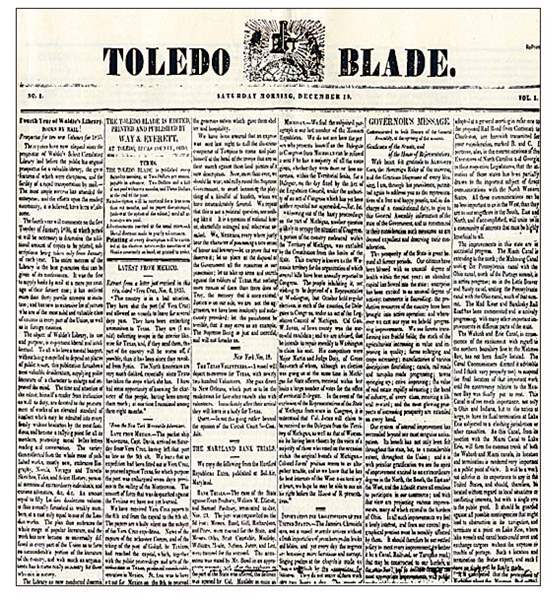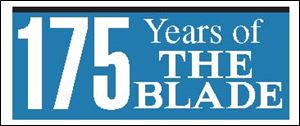
Blade looks to its roots in 2010
1/1/2010
The first Toledo Blade was published Dec. 19, 1835, with news from as far away as France. On the Washington front, the paper reported: 'Little has been done as yet in Congress.' The paper advised that its publisher, a medical doctor, could be reached by day at the newspaper office and through the night at the Mansion House Hotel.

On Saturday morning, Dec. 19, 1835, raw pages of history rolled off a printing press with the publication of No. 1, Vol. 1 of the Toledo Blade.
Brimming with hot-topic news - railroads and canals are coming - and folksy advertisements - first-rate pair of working oxen for sale - the four-page newspaper packed in extras too.
It featured poetry and song: "Wake! ye sons of Texas wake! God and Freedom call you now"; a fresh motto "Truth Without Fear," and a cutting-edge explanation of its name - "Our blade has no elasticity, it will break before it will bend."
Today, as the calendar flips to Jan. 1, 2010, The Blade begins a year-long observance of its founding, a commemoration of 175 years of deadlines and headlines.
The newspaper has inked its place of prominence in the American press in the decades since that first slim copy was edited, printed, and published by Way & Everett in what was called "the village of Toledo."
Ah, what a village it was, what with the ringing sounds of the ax, the grating of the saw, the rattling strokes of the hammer. Welcome noise indeed, noted a writer in the inaugural issue.
"... The forest is disappearing rapidly before the sinewy arms of the sturdy immigrant; buildings are springing up with a rapidity which seems magical; carpenters, bricklayers, mechanics of every description are confused by the vast amount of business proffered them day after day," the newspaper chronicled on that first Saturday morning.
A year or two earlier, scarcely a house was reflected in the waters of the Maumee River, and "now a flourishing village meets the view."

The first Toledo Blade was published Dec. 19, 1835, with news from as far away as France. On the Washington front, the paper reported: 'Little has been done as yet in Congress.' The paper advised that its publisher, a medical doctor, could be reached by day at the newspaper office and through the night at the Mansion House Hotel.
Wharves had been constructed, steam boats daily unloaded their freight, and numerous immigrants stood about, eager to place their feet on the land of their adoption, their future homes.
The first Toledo Blade touted the latest census numbers showing the settlement's population, taken on Dec. 1, 1835, at just over 1,200. The number of "souls" who landed on the wharves totaled more than 10,000, perhaps explaining why the village of Toledo was home to nearly 540 buildings of all descriptions, including a post office, printing presses, land offices, saw mills, grist mill, dry goods stores, hardware and grocery and drug stores, bakeries, cabinet shops, sash manufactory, copper shops and tailor shops, brick yards, and shoe and leather stores.
Several businesses hawked their wares in that first edition. Silk and fur hats, hollow ware, boxes of Pittsburgh and Jamestown Glass, books, liquors, prime pork, boots and shoes, sugars and teas. Cutlery. Nails, Shotguns. House trimmings. More than one advertisement coaxed customers with the tease line of "cheap goods."
Although the newspaper in late 1835 referred to the "village of Toledo," it wasn't officially incorporated until months later.
In other words, before there was a Toledo, there was a Blade.
"There never has been a Toledo without The Blade," said John Robinson Block, publisher and editor-in-chief of The Blade. "Toledo has never existed without The Blade. We've been part of all of Toledo's history and through its different epochs."
A primary reason for the newspaper's establishment was to promote the municipality that resulted when pioneer settlements of Port Lawrence and Vistula were incorporated as Toledo, Mr. Block said.
And, too, the newspaper had other early interests, such as the border dispute between Ohio and the Territory of Michigan over jurisdiction of this area.
One of the reasons The Blade was founded was to promote the idea that Ohio was the legitimate sovereign entity in the Toledo area, Mr. Block said. The paper opposed the Territory of Michigan's claims to the mouth of the Maumee.
The newspaper also provided a voice for the Whig party in its political warfare with the Democrats in the newly formed county of Lucas, named for then-Ohio Governor Robert Lucas.
Northwest Ohio was the last region of the state to be settled, and the Great Black Swamp made Toledo a rather difficult place for the pioneers, Mr. Block said. "Malaria was a constant in early Toledo."
The Blade's first issue probably was printed on a hand press, possibly in a log cabin, and transported on a wagon over rutted roads, Mr. Block said.
At that time, he said, Toledo would have been a collection of log buildings in the middle of the Great Black Swamp, the least desirable part of Ohio to settle, but Lake Erie was opening to navigation, the steam boat had been invented, and Ohio was embarking on a massive construction program to build canals.
History and The Blade have shared space for 175 years.
Topics covered in that first issue included slavery; the new Ohio Turnpike system; the cost of road repairs; regulation of schools; a proposed new State House, the need for more prison space, and arms provisions (sabres, muskets, pistols) for the Ohio Militia.
Frontier journalism blended notes, quotes, and anecdotes with the latest news about the governor, the president, and the state legislature.
This was decades before "political correctness" cropped up.
Consider the printed message from Governor Lucas which included the latest tally on how many "idiots" and "lunatics" lived in Ohio's counties. Or consider the account of a celebrated sculptor of the Emperor Charles V who "got punished one day by a lady of Bologna, to whom he took it into his head to make love in a foppish manner."
The oldest continuous business in Toledo, the newspaper was published on Saturdays until it became a tri-weekly in May, 1846. With the advent of the telegraph, the paper became a daily publication in 1848.
The Toledo Blade occupied the first building of its own, at the northeast corner of Summit Street and Madison Avenue, in 1853, and several moves later, The Toledo Blade opened the doors of its current location at 541 Superior St., in 1927 after President Calvin Coolidge, seated in the White House, sent the electrical flash from a gold telegraph key that started the presses whirling.
During all but its first 30 years, the newspaper has been owned and operated by two families: the Lockes from 1865 to 1926 and the Blocks from 1926 to the present.
The newspaper's name changed to The Blade from The Toledo Blade in 1960, reflecting the newspaper's substantial circulation and readership outside Toledo and its position as the major daily newspaper in northwest Ohio and southeast Michigan.
As a window on the world, the newspaper has provided dramatic details and colorful coverage on thousands of life-changing events since 1835.
Floods and fires, muggings and mobsters. Wars and natural disasters. Labor-management hostilities. Airplane crashes, volcanic eruptions. Accidents and accomplishments.
Major local stories in the recent past have included the plane crash that killed 22 people in 1960, the Maumee Chemical Co. explosion in 1963, the Palm Sunday tornado in 1965, and the Blizzard of 1978.
The Blade has also been a journalistic leader, winning major awards including the 2004 Pulitzer Prize for investigative reporting for its series on unreported atrocities during the Vietnam War. The newspaper was a Pulitzer finalist twice in this decade - in 2000 for an investigation into the American beryllium industry and in 2006 for The Blade's "Coingate" coverage, which resulted in the conviction of former GOP fund-raiser and rare coin dealer Tom Noe and former Gov. Bob Taft.
Events will be held throughout 2010 to commemorate The Blade's 175th anniversary, Mr. Block said.
"In Toledo there is no other institution like The Blade. Virtually nothing in Toledo is as old," he said.
The Blade is known for its long-standing tradition of publishing accurate, truthful stories, and as a result of its credibility, the newspaper is widely respected, he said.
He said he's not aware of any major stories or major facts in a story that ever had to be retracted because it was discovered or determined what was printed was not true. "I think people do respect that. We report the truth and most people in Toledo acknowledge that."
In John M. Harrison's book about The Blade's first 150 years, he noted the future of newspapers was far from promising. Some 25 years later, in a world of texts, Twitters, Tweets, and instant online news, the industry is in transition.
As to the future of The Blade, Mr. Block said people still need news and information, and "We obviously wouldn't be celebrating life of 175 year duration only to write our own obituary. We're alive."
Many newspapers started operations in the 1830s, but only a few have survived through 175 years of continuous operation.
"It's remarkable. There's no question about that," said Ted Ligibel of Lambertville, a noted historian. "Just given the nature of businesses in America, one that has survived this long is remarkable."
Historians often use newspapers as a primary source for information about people, places, and events, he said, and The Blade has tremendous value from that standpoint.
Mr. Ligibel, director of the Historic Preservation Program at Eastern Michigan University, said he obtained valuable information from The Blade when he was working on his master's thesis on Toledo architect Edward O. Fallis.
It's interesting to look back on the history of The Blade, he said, noting President Lincoln reportedly was reading a Toledo Blade news item shortly before his assassination.
The Blade's had a good, long run for 175 years, Mr. Ligibel said.
"It really is unheard of in this day and age, something with that much continuity," he said. "It really is something to celebrate."
Contact Janet Romaker at:
jromaker@theblade.com or
419-724-6006.